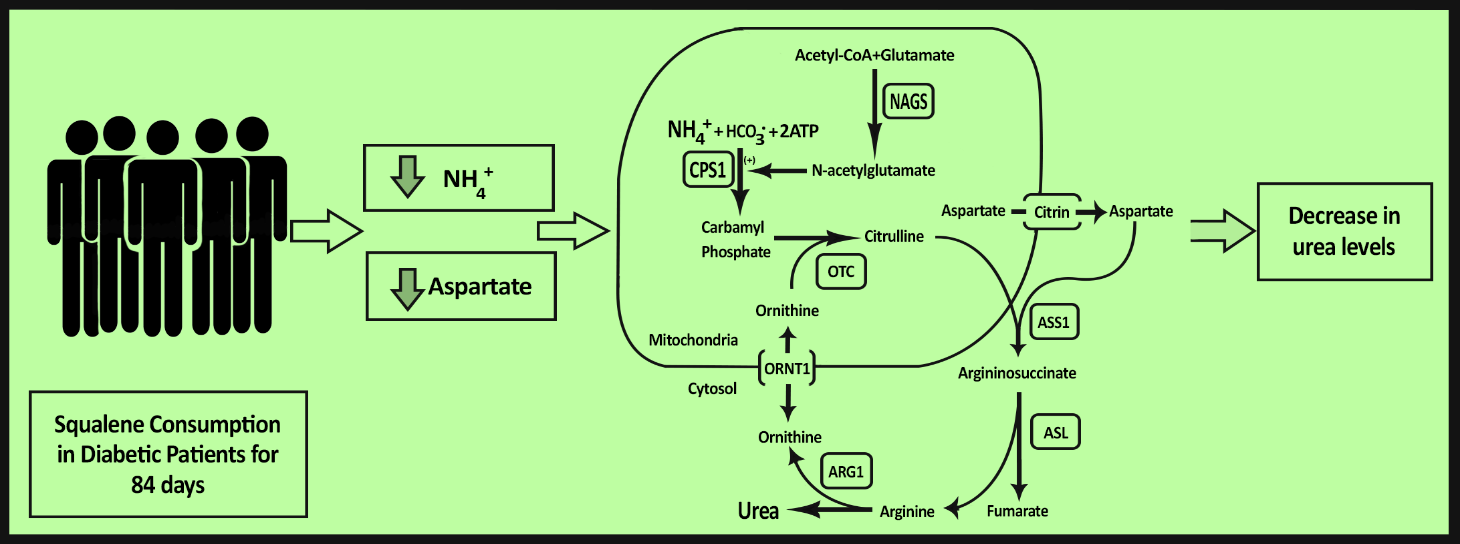Investigating the changes of some enzymes and metabolites of the Urea cycle in patients with type 2 diabetes treated with squalene
DOI:
https://doi.org/10.31989/bchd.v6i5.1085Abstract
Background: Type 2 diabetes mellitus is a chronic disease that diminishes the body’s ability to regulate glucose levels due to the lack of insulin produced. In recent studies, squalene has been reported to have beneficial effects for diabetic patients, especially within the liver where the urea cycle takes place.
Objective: Our main goal was to evaluate the molecular effects of different doses of squalene on the enzymes, intermediates, and molecules of the urea cycle, in order to determine if squalene has beneficial effects among groups of people with type 2 diabetes mellitus. The enzymes and molecules that are being studied are ornithine transcarbamylase (OTC), arginosuccinate synthetase (ASS), arginase, carbamoyl-phosphate synthetase 1 (CSP1), urea, aspartate, and ammonium ion (NH4+).
Methods: In this study, healthy volunteers were categorized as the healthy control (group 1) and volunteers with type 2 diabetes mellitus were selected. The patients with diabetes were divided up into 4 groups. Group 2 consists of the patients that will not be treated with squalene. Groups 3, 4, 5 were treated with 200, 400, 600 mg, respectively. The patients were treated with their respective amounts every 14 days for the duration of 84 days. The enzymes and molecules were measured on days 1, 14, 28, 56, and 84.
Results: The squalene-treated diabetic groups were compared to group 2, who was not treated with any squalene to determine the differences between the parameters. Throughout the 84 days, it was observed that NH4+ or ammonium molecules decreased in all treated diabetic patients with high statistical difference (P < 0.05). For the majority of the diabetic patients treated with squalene, there was also a decrease in aspartate. The other parameters did not have consistent significant differences (P > 0.05).
Conclusion: Based on the findings of this study, the addition of various doses of squalene to a diabetic patient’s diet decreased the amount of ammonium and aspartate in the body. As ammonium is the direct product of the urea cycle, it is evident that squalene does play a key role in reducing the amount of ammonium in a diabetic patient to a healthier level.

Keywords: Diabetes mellitus, urea cycle, enzyme, metabolite, squalene.
Downloads
Published
Issue
Section
License
Copyright (c) 2023 FFC/Bioactive Compounds in Health and Disease

This work is licensed under a Creative Commons Attribution-NonCommercial 4.0 International License.
Authors retain the copyright of their articles and grant the Functional Food Center (FFC) and its journals the right of first publication under the terms of the Creative Commons Attribution 4.0 International License.
This license permits unrestricted use, distribution, and reproduction in any medium, including commercial use, provided the original author(s) and source are properly credited. Authors may post and share their published work freely, provided that the original publication in this journal is acknowledged.
By submitting to this journal, authors confirm that their manuscripts are original, not under consideration elsewhere, and that they hold the necessary rights to grant this license. The Functional Food Center encourages open scientific exchange and allows derivative and extended works, provided attribution to the original publication is maintained.